Video of the Week:
Crabgrass Prevention in Lawns
Vegetables:
Blanching Cauliflower
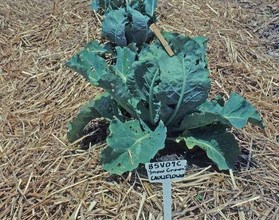
Setting Up Water Teepees
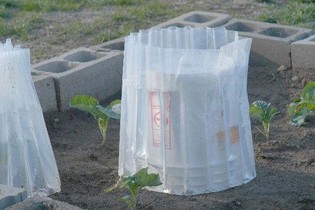
The bucket works much better if it is modified by taking the handle off and drilling a hole (use a hole saw bit) in the bottom of the bucket. Place the bucket upside down over the plant you wish to protect and place the water teepee over the bucket.
Now the bucket will support the teepee as it is filled. Once the teepee is filled, the bucket can be removed by sticking your finger into the hole and pulling straight up. You may also want to support the teepee after it is filled by using a metal rod (rebar or an electric fence post) on the inside of the teepee. The metal rod is pushed into the soil to keep the teepee from collapsing from high winds. (Ward Upham)
Fertilizing Grapes
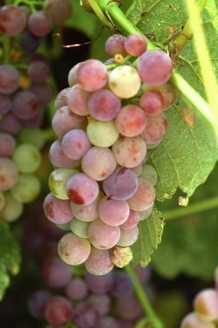
Second Year: Apply 1 cup of a 10-10-10 fertilizer per vine as growth begins in the spring. Fertilizers should be spread evenly from the trunk out 3 to 5 feet.
Mature Vines (3 years and older): If the soil test recommends phosphorus and potassium, use a 10-10-10 fertilizer at the rate of 2 cups per mature vine. Fertilizers should be spread evenly from the trunk out 3 to 5 feet.
If, however, there are adequate levels of phosphorus and potassium, add 3/4 cup of a high nitrogen fertilizer such as
a 27-3-3, 29-5-4, 30-3-3 or something similar instead of the 10-10-10. Though recommended for lawns, these fertilizers will also work well as long as they do not contain weed killers or crabgrass preventers. Fertilizers should be spread evenly from the trunk out 3 to 5 feet. (Ward Upham)
Fertilizing the Home Orchard
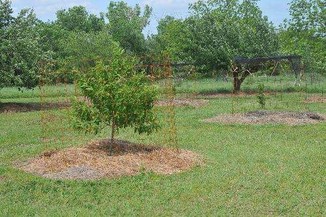
Trees 1 to 2 years old, apply one-fourth cup of fertilizer per tree; Trees 3 to 4 years old, apply one-half cup per tree;
Trees 5 to 10 years old, apply 1 to 2 cups per tree; Trees more than 10 years old, apply 2 to 3 cups.
You may also use nitrate of soda (16-0-0) but double the rate recommended above. If a soil test calls for phosphorus and potassium, use a 10-10-10 but triple the rate.
On apple trees, last year's growth should be 8 to 10 inches, cherries should have 10 to 12 inches, and peaches should equal 12 to 15 inches of terminal growth. If less than this, apply the higher rate of fertilizer, and if more, apply the lesser amount.
Spread all fertilizer evenly on the ground away from the trunk of the tree and to the outer spread of the branches. Water in the fertilizer. (Ward Upham)
Turfgrass:
Seeding Cool-Season Lawns in the Spring
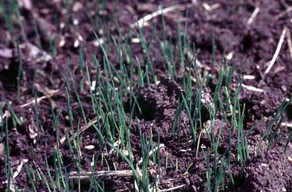
- Some of the most serious lawn weeds such as crabgrass and foxtail emerge in the spring. Since they are warm-season weeds, they will compete and often crowd out young, tender cool-season grasses during the heat of summer.
- The most stressful time of year for cool-season grasses is summer, not winter. Poorly established lawns may die out during the summer due to heat and drought stress.
- A lawn often gets more use during the summer, leading to increased compaction and traffic stress.
If an area needs to be established in the spring, sodding is much more likely to be successful than seeding. Sodding provides stronger, more mature plants that are better able to withstand stress and prevent weed invasion. (Ward Upham)
Henbit and Chickweed in Lawns
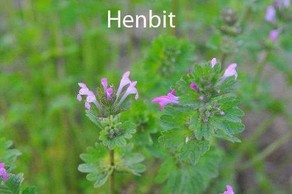
Both these plants are winter annuals and start to grow in the fall. They spend the winter as small plants and so most people do not pay much attention to them until they start to flower in the spring. Trying to kill either one at this late stage with a herbicide usually is a waste of time and money. Though plants may be burned back, they will rarely be killed. So what should you do? Remember, these are winter annuals that will die as soon as the weather turns hot. Keep the lawn mowed until nature takes its course.
However, you can do something next fall that will help next spring. Henbit and chickweed usually germinate about mid-October. Spraying with 2,4-D, Weed-B-Gon, Weed Free Zone, Weed Out, or Trimec in late October to early November can go a long way toward eliminating these plants as they are small and relatively easy to control. Choose a day that is at least 50 degrees F so the young plants are actively growing and will take up the chemical.
Spot treating will probably be needed in the spring (March) to catch the few plants that germinate late. Use Weed Free Zone, Speed Zone, Weed Out, Weed-B-Gon, Trimec, or one of the special henbit herbicides early in the spring before they have put on much growth. (Ward Upham)
Pests:
First Generation Nantucket Pine Tip Moths
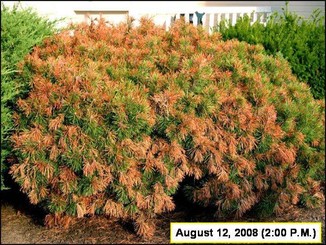
The best time for control of the first generation larvae is a spray 10 days following peak flight of the insect. For those of you that treat for this insect, the OPTIMUM day for control will be on April 10, 2016 for the Wichita area. Note that growers further north will spray later. Watch the Snowdrift crabs for timing.
This is a pest primarily of scotch, ponderosa and mugo pines. Thanks to Willy Goevert of 4C Christmastree Farm that does the local pheromone trapping and monitoring of this pest. We realize that not every susceptible tree cannot be sprayed on the same day, but for Christmastree growers it is best to treat the scotch pines on that day if possible. (Ward Upham)
Contributors: Ward Upham, Extension Associate
 RSS Feed
RSS Feed
